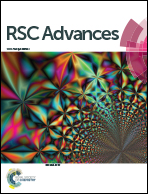Development of quantitative 13C NMR characterization and simulation of C, H, and O content for pyrolysis oils based on 13C NMR analysis†
Abstract
Bio-oil is a valuable liquid product obtained from pyrolysis of biomass and it contains tens of hundreds of compounds, which brings about difficulties for characterization with various analytical methods. 13C NMR has advantages over other detection methods as it can characterize the entire composition of bio-oil and distinguish different types of carbon. But various shortcomings limit the application of 13C NMR. This study was carried out to develop a quantitative 13C NMR method to determine different functional groups in pyrolysis bio-oils with short NMR time and good accuracy, and propose a simulation of C, H, and O content for pyrolysis oils based on 13C NMR analysis. In order to solve long-term NMR problems, relax reagent has been added and the results show that it is an effective way to shorten the NMR time. Moreover, the aging problem is not obvious in the short-term NMR test, so the effect of aging on the test results can be neglected. Three types of substances with different oxygen content have been employed to verify the feasibility of the C, H, and O calculation methods and the result errors of all elements are small, which shows it is reliable for the simulation data of C, H and O content.



 Please wait while we load your content...
Please wait while we load your content...